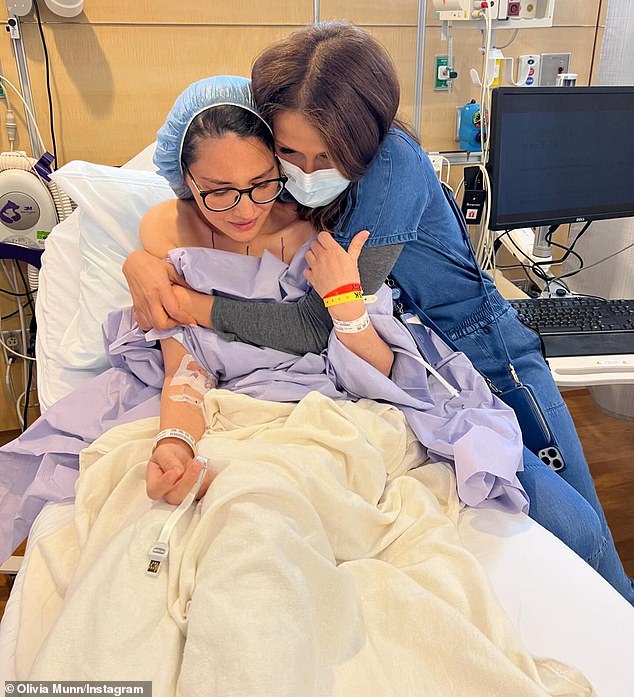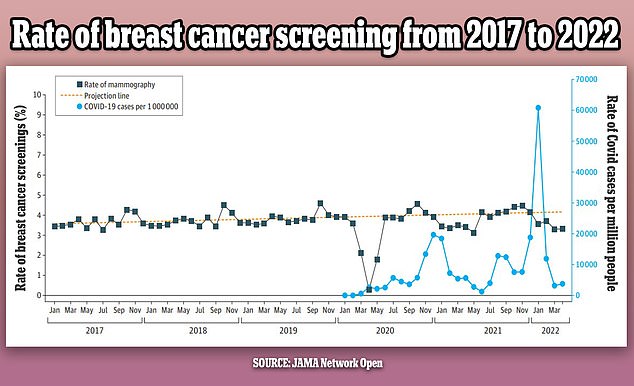- The five minute test consists of only ten questions and can be done online
- Olivia Munn Credits Breast Cancer Risk Assessment With ‘Saving Her Life’
- READ MORE: Why it took Olivia Munn THREE TIMES to get the right diagnosis
<!–
<!–
<!– <!–
<!–
<!–
<!–
An online risk assessment calculator played a crucial role in Olivia Munn’s discovery that she had breast cancer.
The actress, 43, revealed on Wednesday that she was diagnosed with the disease just two months after getting the all-clear from a mammogram and DIY genetic testing, which claimed to detect 90 genes linked to cancer.
It was her doctor’s decision to calculate her breast cancer risk assessment score that ‘saved her life’, according to Munn, because it led to further tests that finally got it right.
The risk test uses a few simple questions and looks at things like family history of the disease and the age when the woman had her first child – which can increase the risk of cancer.
The calculator put Munn’s chance of developing breast cancer at 37 percent, prompting doctors to conduct even closer examinations.
A FULL LIST OF ASSESSMENT QUESTIONS IS AT THE BOTTOM OF THIS ARTICLE ALONG WITH A LINK TO THE OFFICIAL TEST

Olivia Munn has revealed she was diagnosed with luminal B breast cancer last year – after undergoing four operations in the last 10 months. She Credited Her OBGYN (Here) For ‘Saving My Life’


The graph above shows the changes in breast cancer screenings (black line) since 2017 per month. It also shows a predicted screening rate (yellow dashed line) and Covid infection rate (blue line) in the US during the same period. Screenings were initially stable, but fell in the first year of the pandemic by as much as 14 percent
Munn was diagnosed with luminal B breast cancer in both breasts at an early stage.
She then had a double mastectomy to prevent the cancer from spreading to other parts of the body when it becomes fatal.
According to the National Cancer Institute, a breast cancer risk assessment tool uses a statistical model to estimate a woman’s risk of developing breast cancer in the next five years as well as over her lifetime, or up to about age 90.
The calculator consists of questions about the woman’s medical, reproductive and family history.
It is typically used by healthcare professionals, but patients can also complete the test online. Women who do this are encouraged to discuss their results with their doctor.
The two most common models are Gail model and Tyrer-Cuzick Risk Assessment Calculator.
The Gail model calculates the patient’s estimated five-year risk and lifetime risk of developing breast cancer, as well as the average risk for women in the United States of the same age and race.
“Although a woman’s risk can be accurately estimated, these predictions do not allow us to say exactly which woman will develop breast cancer.
“In fact, some women who do not develop breast cancer have higher risk estimates than some women who do,” says the National Cancer Institute’s website.
The Gail Model consists of ten questions, including age, race/ethnicity, age of woman’s first period, and age of first child.
It takes about five minutes to complete and calculates the risk for women aged between 35 and 85.
However, the test cannot accurately estimate the risk of breast cancer for women who carry a breast cancer-causing mutation in BRCA1 or BRCA2 or women with a previous history of invasive or in situ breast cancer (lobular carcinoma in situ or ductal carcinoma in situ).
Munn’s doctor determined that based on her age, family history and the fact that she had her first child after the age of 40, the actress had a more than one in three risk of developing the disease.
The average risk for a woman in her 40s is typically 0.9 percent for five years and about 12 percent for her lifetime.
A person with a high score on a breast cancer risk assessment may be advised to have extra breast examinations as well as a mammogram.
In a draft recommendation last year, the US Preventive Services Task Force said all women at average risk of breast cancer should start screening with mammograms at age 40 to reduce their risk of dying from the disease.
The American Cancer Society recommends that women who are at high risk for breast cancer based on certain factors get a breast MRI and an annual mammogram starting at age 30.
